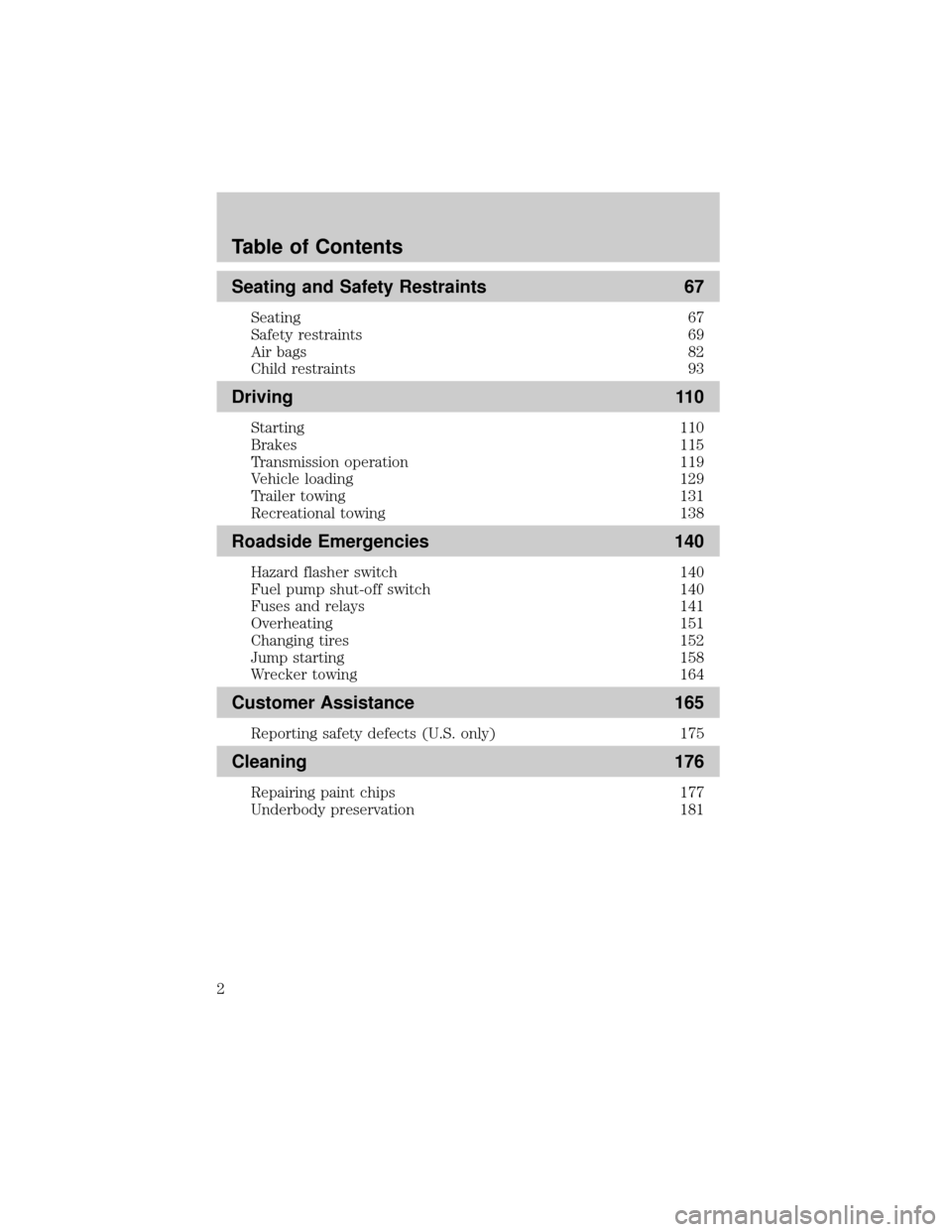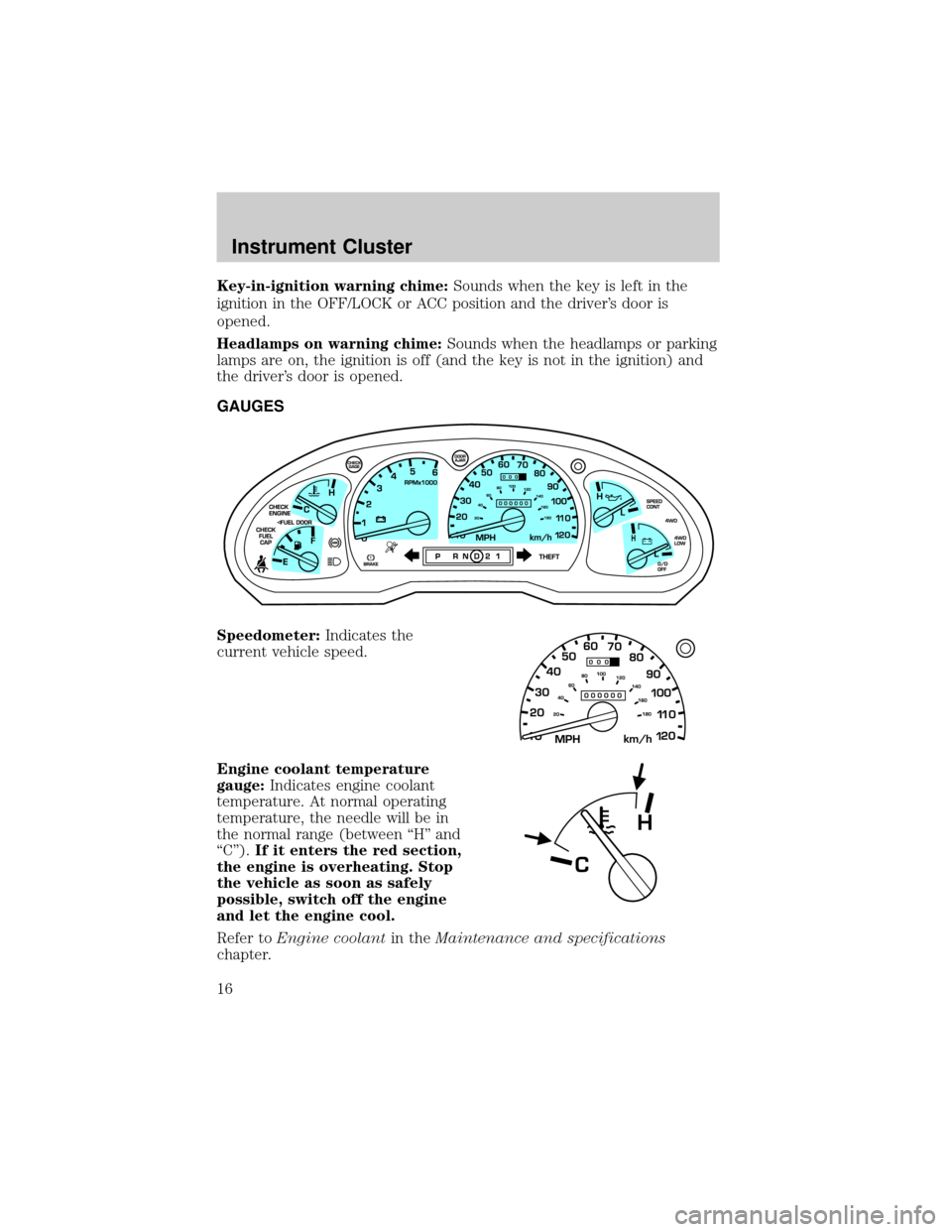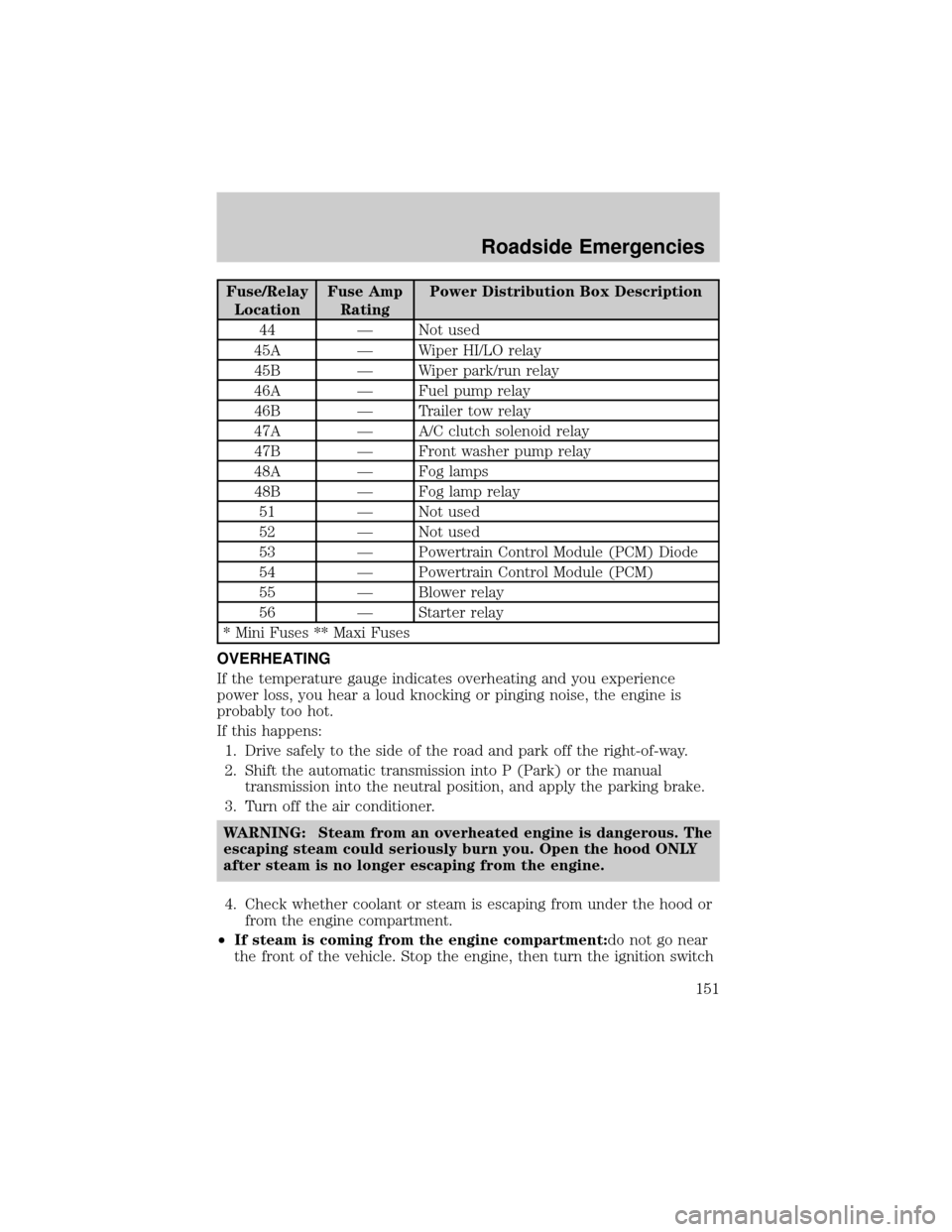overheating MAZDA MODEL B2300 2003 Owners Manual (in English)
[x] Cancel search | Manufacturer: MAZDA, Model Year: 2003, Model line: MODEL B2300, Model: MAZDA MODEL B2300 2003Pages: 248, PDF Size: 2.71 MB
Page 2 of 248

Seating and Safety Restraints 67
Seating 67
Safety restraints 69
Air bags 82
Child restraints 93
Driving 110
Starting 110
Brakes 115
Transmission operation 119
Vehicle loading 129
Trailer towing 131
Recreational towing 138
Roadside Emergencies 140
Hazard flasher switch 140
Fuel pump shut-off switch 140
Fuses and relays 141
Overheating 151
Changing tires 152
Jump starting 158
Wrecker towing 164
Customer Assistance 165
Reporting safety defects (U.S. only) 175
Cleaning 176
Repairing paint chips 177
Underbody preservation 181
Table of Contents
2
Page 16 of 248

Key-in-ignition warning chime:Sounds when the key is left in the
ignition in the OFF/LOCK or ACC position and the driver's door is
opened.
Headlamps on warning chime:Sounds when the headlamps or parking
lamps are on, the ignition is off (and the key is not in the ignition) and
the driver's door is opened.
GAUGES
Speedometer:Indicates the
current vehicle speed.
Engine coolant temperature
gauge:Indicates engine coolant
temperature. At normal operating
temperature, the needle will be in
the normal range (between ªHº and
ªCº).If it enters the red section,
the engine is overheating. Stop
the vehicle as soon as safely
possible, switch off the engine
and let the engine cool.
Refer toEngine coolantin theMaintenance and specifications
chapter.
C
H
Instrument Cluster
16
Page 151 of 248

Fuse/Relay
LocationFuse Amp
RatingPower Distribution Box Description
44 Ð Not used
45A Ð Wiper HI/LO relay
45B Ð Wiper park/run relay
46A Ð Fuel pump relay
46B Ð Trailer tow relay
47A Ð A/C clutch solenoid relay
47B Ð Front washer pump relay
48A Ð Fog lamps
48B Ð Fog lamp relay
51 Ð Not used
52 Ð Not used
53 Ð Powertrain Control Module (PCM) Diode
54 Ð Powertrain Control Module (PCM)
55 Ð Blower relay
56 Ð Starter relay
* Mini Fuses ** Maxi Fuses
OVERHEATING
If the temperature gauge indicates overheating and you experience
power loss, you hear a loud knocking or pinging noise, the engine is
probably too hot.
If this happens:
1. Drive safely to the side of the road and park off the right-of-way.
2. Shift the automatic transmission into P (Park) or the manual
transmission into the neutral position, and apply the parking brake.
3. Turn off the air conditioner.
WARNING: Steam from an overheated engine is dangerous. The
escaping steam could seriously burn you. Open the hood ONLY
after steam is no longer escaping from the engine.
4. Check whether coolant or steam is escaping from under the hood or
from the engine compartment.
²If steam is coming from the engine compartment:do not go near
the front of the vehicle. Stop the engine, then turn the ignition switch
Roadside Emergencies
151
Page 224 of 248

6. Install the dipstick making sure it is fully seated in the filler tube.
7. Remove the dipstick and inspect the fluid level. The fluid should be
in the designated area for normal operating temperature or ambient
temperature.
Low fluid level
Do not drive the vehicle if the fluid
level is at the bottom of the dipstick
and the ambient temperature is
above 10ÉC (50ÉF).
Correct fluid level
The transmission fluid should be checked at normal operating
temperature 66ÉC-77ÉC (150ÉF-170ÉF) on a level surface. The normal
operating temperature can be reached after approximately 30 km (20
miles) of driving.
You can check the fluid without driving if the ambient temperature is
above 10ÉC (50ÉF). However, if fluid is added at this time, an overfill
condition could result when the vehicle reaches normal operating
temperature.
The transmission fluid should be in
this range if at normal operating
temperature (66ÉC-77ÉC
[150ÉF-170ÉF]).
The transmission fluid should be in
this range if at ambient temperature
(10ÉC-35ÉC [50ÉF-95ÉF]).
High fluid level
Fluid levels above the safe range
may result in transmission failure.
An overfill condition of transmission
fluid may cause shift and/or
engagement concerns and/or
possible damage.
High fluid levels can be caused by an overheating condition.
Adjusting automatic transmission fluid levels
Before adding any fluid, make sure the correct type is used. The type of
fluid used is normally indicated on the dipstick and also in the
Lubricant specificationssection in this chapter.
Maintenance and Specifications
224
Page 243 of 248

Jump-starting your vehicle ......158
K
Keys
positions of the ignition .........110
L
Lamps
bulb replacement
specifications chart ..................40
cargo lamps ...............................39
daytime running light ...............38
fog lamps ...................................38
headlamps .................................38
headlamps, flash to pass ..........39
instrument panel, dimming .....39
interior lamps .....................40±41
replacing
bulbs .................. 40±41, 43, 45±46
Lane change indicator
(see Turn signal) ........................40
LATCH anchors .........................106
Lights, warning and indicator ....12
anti-lock brakes (ABS) ..........116
Load limits .................................129
GAWR ......................................129
GVWR ......................................129
trailer towing ..........................129
Loading instructions .................129
Lubricant specifications ...235±236
Lumbar support, seats ...............68
M
Manual transmission .................122
fluid capacities ........................232
lubricant specifications ..........236
reverse .....................................123Mirrors
automatic dimming rearview
mirror ........................................50
cleaning ...................................179
side view mirrors (power) .......53
Motorcraft parts ........................214
O
Octane rating ............................213
Oil (see Engine oil) ..................196
Overdrive .....................................56
Overheating ...............................151
P
Parking brake ............................116
Power distribution box
(see Fuses) ...............................145
Power door locks ........................59
Power point .................................49
Power steering ..........................117
fluid, checking and adding ....220
fluid, refill capacity ................232
fluid, specifications .........235±236
Power Windows ...........................49
Preparing to drive your
vehicle ........................................118
R
Radio ..........................19, 21, 23, 27
Relays ........................................141
Remote entry system ...........59±60
illuminated entry ......................63
locking/unlocking doors ...........59
Index
243